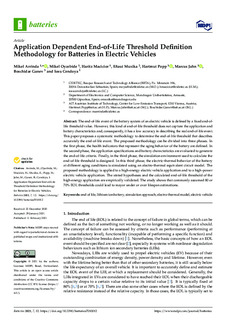| dc.rights.license | Attribution 4.0 International | * |
| dc.contributor.author | Muxika Olasagasti, Eñaut | |
| dc.contributor.other | Arrinda Martínez, Mikel | |
| dc.contributor.other | Oyarbide Urquiz, mi | |
| dc.contributor.other | Macicior, Haritz | |
| dc.contributor.other | Popp, Hartmut | |
| dc.contributor.other | Jahn, Marcus | |
| dc.contributor.other | Ganev, Boschidar | |
| dc.contributor.other | Cendoya, Iosu | |
| dc.date.accessioned | 2021-06-07T15:07:09Z | |
| dc.date.available | 2021-06-07T15:07:09Z | |
| dc.date.issued | 2021 | |
| dc.identifier.issn | 2313-0105 | en |
| dc.identifier.other | https://katalogoa.mondragon.edu/janium-bin/janium_login_opac.pl?find&ficha_no=163668 | en |
| dc.identifier.uri | https://hdl.handle.net/20.500.11984/5313 | |
| dc.description.abstract | The end-of-life event of the battery system of an electric vehicle is defined by a fixed end-oflife threshold value. However, this kind of end-of-life threshold does not capture the application and battery characteristics and, consequently, it has a low accuracy in describing the real end-of-life event. This paper proposes a systematic methodology to determine the end-of-life threshold that describes accurately the end-of-life event. The proposed methodology can be divided into three phases. In
the first phase, the health indicators that represent the aging behavior of the battery are defined. In the second phase, the application specifications and battery characteristics are evaluated to generate the end-of-life criteria. Finally, in the third phase, the simulation environment used to calculate the end-of-life threshold is designed. In this third phase, the electric-thermal behavior of the battery at different aging conditions is simulated using an electro-thermal equivalent circuit model. The proposed methodology is applied to a high-energy electric vehicle application and to a high-power electric vehicle application. The stated hypotheses and the calculated end-of-life threshold of the high-energy application are empirically validated. The study shows that commonly assumed 80 or 70% EOL thresholds could lead to mayor under or over lifespan estimations. | en |
| dc.description.sponsorship | Comisión Europea | es |
| dc.language.iso | eng | en |
| dc.publisher | MDPI | en |
| dc.rights.uri | http://creativecommons.org/licenses/by/4.0/ | * |
| dc.subject | end of life | en |
| dc.subject | lithium-ion batteries | en |
| dc.subject | simulation approach | en |
| dc.subject | electro-thermalmodel | en |
| dc.subject | electric vehicle | en |
| dc.title | Application Dependent End-of-Life Threshold Definition Methodology for Batteries in Electric Vehicles | en |
| dcterms.accessRights | http://purl.org/coar/access_right/c_abf2 | en |
| dcterms.source | Batteries | en |
| local.contributor.group | Teoría de la señal y comunicaciones | es |
| local.description.peerreviewed | true | en |
| local.identifier.doi | https://doi.org/10.3390/batteries7010012 | en |
| local.relation.projectID | info:eu-repo/grantAgreement/EC/H2020/770054/EU/Industrial Modular Battery Pack Concept Addressing High Energy Density, Environmental Friendliness, Flexibility and Cost Efficiency for Automotive Applications/iModBatt | en |
| local.rights.publicationfee | APC | en |
| local.contributor.otherinstitution | https://ror.org/03vgz7r63 | es |
| local.contributor.otherinstitution | https://ror.org/04knbh022 | es |
| local.source.details | Batteries. Vol. 7. N. 1. N. artículo 12, | en |
| oaire.format.mimetype | application/pdf | |
| oaire.file | $DSPACE\assetstore | |
| oaire.resourceType | http://purl.org/coar/resource_type/c_6501 | en |
| oaire.version | http://purl.org/coar/version/c_970fb48d4fbd8a85 | en |








